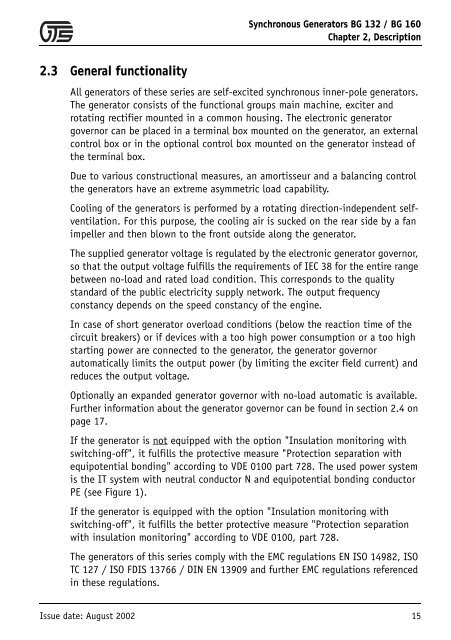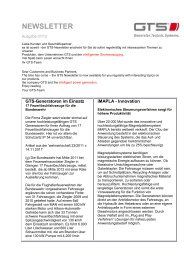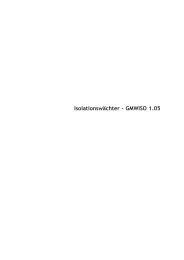Synchronous Generators BG 132 and BG 160
Synchronous Generators BG 132 and BG 160
Synchronous Generators BG 132 and BG 160
You also want an ePaper? Increase the reach of your titles
YUMPU automatically turns print PDFs into web optimized ePapers that Google loves.
<strong>Synchronous</strong> <strong>Generators</strong> <strong>BG</strong> <strong>132</strong> / <strong>BG</strong> <strong>160</strong><br />
Chapter 2, Description<br />
2.3 General functionality<br />
All generators of these series are self-excited synchronous inner-pole generators.<br />
The generator consists of the functional groups main machine, exciter <strong>and</strong><br />
rotating rectifier mounted in a common housing. The electronic generator<br />
governor can be placed in a terminal box mounted on the generator, an external<br />
control box or in the optional control box mounted on the generator instead of<br />
the terminal box.<br />
Due to various constructional measures, an amortisseur <strong>and</strong> a balancing control<br />
the generators have an extreme asymmetric load capability.<br />
Cooling of the generators is performed by a rotating direction-independent selfventilation.<br />
For this purpose, the cooling air is sucked on the rear side by a fan<br />
impeller <strong>and</strong> then blown to the front outside along the generator.<br />
The supplied generator voltage is regulated by the electronic generator governor,<br />
so that the output voltage fulfills the requirements of IEC 38 for the entire range<br />
between no-load <strong>and</strong> rated load condition. This corresponds to the quality<br />
st<strong>and</strong>ard of the public electricity supply network. The output frequency<br />
constancy depends on the speed constancy of the engine.<br />
In case of short generator overload conditions (below the reaction time of the<br />
circuit breakers) or if devices with a too high power consumption or a too high<br />
starting power are connected to the generator, the generator governor<br />
automatically limits the output power (by limiting the exciter field current) <strong>and</strong><br />
reduces the output voltage.<br />
Optionally an exp<strong>and</strong>ed generator governor with no-load automatic is available.<br />
Further information about the generator governor can be found in section 2.4 on<br />
page 17.<br />
If the generator is not equipped with the option "Insulation monitoring with<br />
switching-off", it fulfills the protective measure "Protection separation with<br />
equipotential bonding" according to VDE 0100 part 728. The used power system<br />
is the IT system with neutral conductor N <strong>and</strong> equipotential bonding conductor<br />
PE (see Figure 1).<br />
If the generator is equipped with the option "Insulation monitoring with<br />
switching-off", it fulfills the better protective measure "Protection separation<br />
with insulation monitoring" according to VDE 0100, part 728.<br />
The generators of this series comply with the EMC regulations EN ISO 14982, ISO<br />
TC 127 / ISO FDIS 13766 / DIN EN 13909 <strong>and</strong> further EMC regulations referenced<br />
in these regulations.<br />
Issue date: August 2002 15














